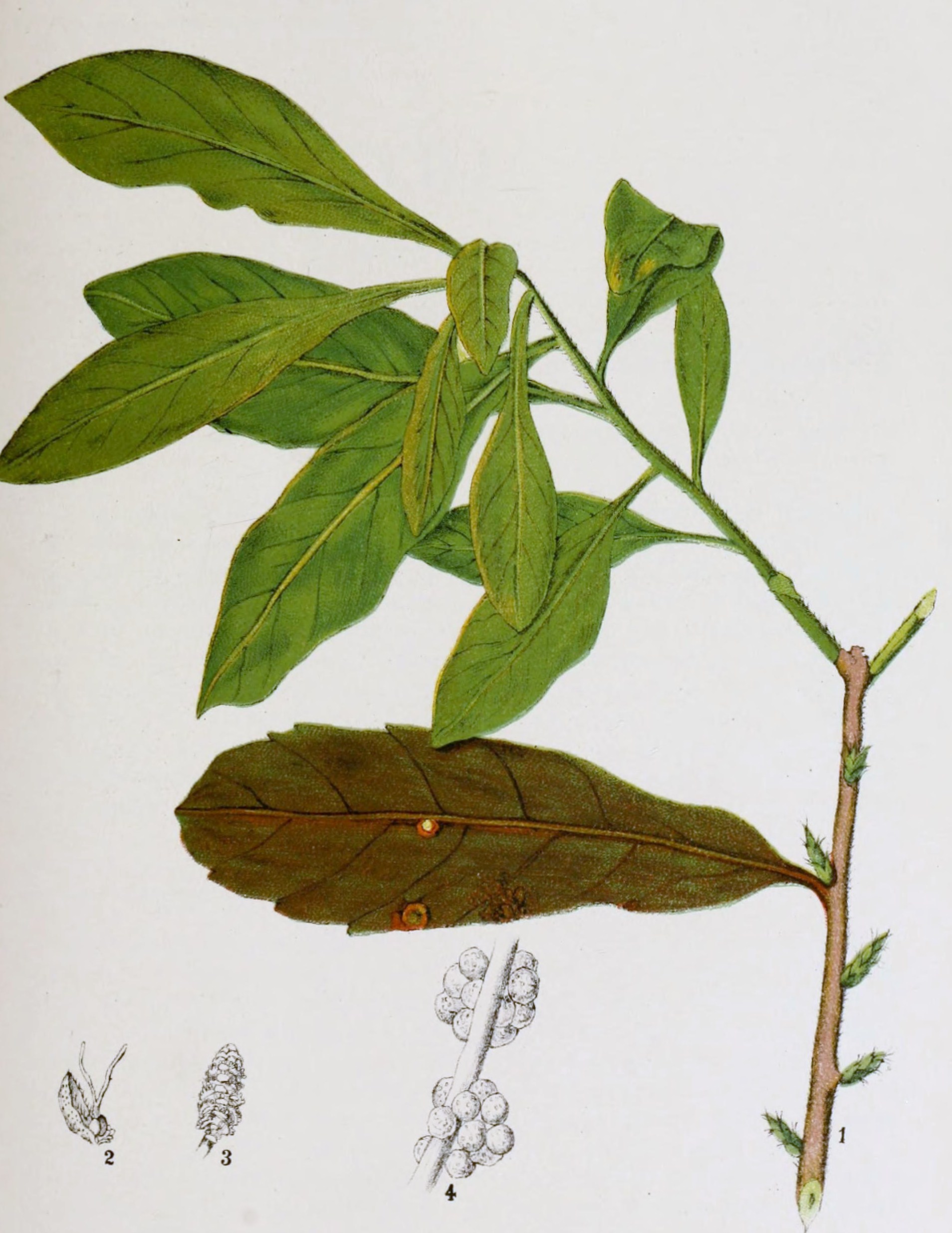
Myrica cerifera (L)
 Synonyms: wax myrtle, myrica, arbre a
souf, myricae cortex, wachsgagle, candleberry, tallow shrub, vegetable tallow,
waxberry, wax myrtle
Synonyms: wax myrtle, myrica, arbre a
souf, myricae cortex, wachsgagle, candleberry, tallow shrub, vegetable tallow,
waxberry, wax myrtle
Order: Myricaceae
Description: Myrica is an evergreen shrub growing up to 2.5m, found in woods and marshes of eastern North America. Covered with smooth, grey bark, the branches bear alternate lanceolate to oblong-lanceolate leaves whose downy undersides are dotted with glands. The yellowish flowers grow in scaly catkins, the male catkins elongated, the female more globular. The fruit is a greyish-white, round, drupe-like nut covered with a waxy crust.
Parts used: root bark, bark, leaves, wax
Constituents: Tannins, triterpenes (including myricadiol), flavonoid glycoside (myricitrin), resin (myrinic acid), gum, volatile oil. The wax consists of glycerides of stearic, palmitic and myristic acids and a small quantity of oleaic acid.
Actions: locally astringent, circulatory stimulant, mild diaphoretic, tonic.
Indications: diarrhoea, mucous colitis, colds, a gargle for sore throats, douche for leucorrhoea, topically for indolent ulcers.
Therapeutics and Pharmacology: Myrica cerifera is a valuable astringent in the treatment of diarrhoea and dysentery and other inflammation and infection of the gastrointestinal tract. It stimulates bile flow. This herb is particularly valuable in mucous colitis. It may be used as a gargle for sore throats or as a douche for leucorrhoea, and can be used both systemically and locally for excessive menstrual bleeding. It is sometimes used to treat post-partum haemorrhage. The powdered bark may be applied topically to indolent ulcers and in poultices for wounds, cuts, slow-healing ulcers and bruises. A hot decoction given in colds and fevers. The infusion has also been recommended for jaundice and scrofula. Myricitrin is bactericidal and encourages the flow of bile. Powdered Myrica can be used as a snuff for nasal congestion.
Combinations: As a digestive stimulant it may be used with Symphytum radix and Agrimonia. It combines well with Quercus in diarrhoea, and with Capsicum and Zingiber it is used to treat circulatory problems, and febrile, cachexic and chronically inflamed conditions.
Caution: Myrica is emetic in large doses. Myricadiol is reported to cause salt retention and potassium excretion.
Preparation and Dosage: (thrice daily)
Regulatory Status: GSL
Decoction: Put 1 teaspoon of bark in a cup of cold water and bring to the boil. Leave for 10-15 minutes. Drink three times a day.
Tincture: 1-3ml three times a day.
Additional Comments: Native Americans took a decoction of the stems and leaves for fever. It was a key astringent used by the Physiomedical herbalists and was a major component of Thomson's composition powder. The wax from the berries was used in candlemaking, hence some of its common names.
Bibliography
BHMA 1983 British Herbal Pharmacopoeia, BHMA, Bournemouth.
Grieve, M. 1931 A Modern Herbal, (ed. C.F. Leyel 1985), London.
Hoffmann, D. 1990 The New Holistic Herbal, Second Edition, Element, Shaftesbury.
Lust, J. 1990 The Herb Book, Bantam, London.
Mabey, R. (ed.) 1991 The Complete New Herbal, Penguin, London.
Mills, S.Y. 1993 The Essential Book of Herbal Medicine, Penguin, London (First published in 1991 as Out of the Earth, Arkana)
Mills, S.Y. 1993 The A-Z of Modern Herbalism, Diamond Books, London.
Wren, R.C. 1988 Potter's New Cyclopaedia of Botanical Drugs and Preparations, C.W.Daniel, Saffron Walden.










